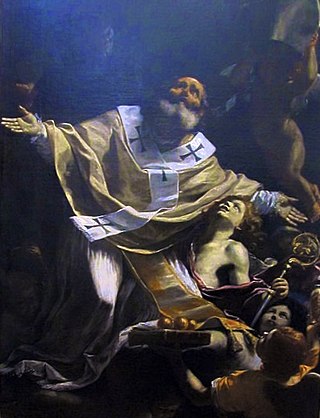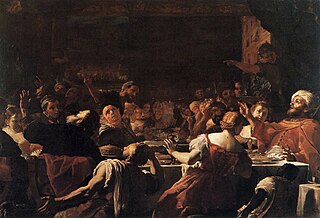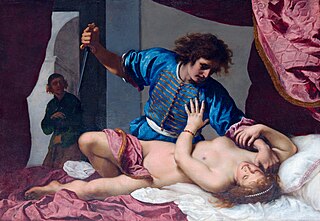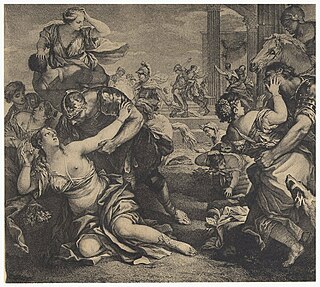
Lucretia and Tarquin (Italian: Lucrezia e Tarquinio) is a 1663 oil painting by Luca Giordano of the legendary rape of Lucretia by Sextus Tarquin, as told by Livy and Ovid, [1] which is now in the Museo di Capodimonte in Naples (Inv. Q 1678). [2]

Lucretia and Tarquin (Italian: Lucrezia e Tarquinio) is a 1663 oil painting by Luca Giordano of the legendary rape of Lucretia by Sextus Tarquin, as told by Livy and Ovid, [1] which is now in the Museo di Capodimonte in Naples (Inv. Q 1678). [2]

The picture was part of the 1862 bequest of Alfonso d'Avalos, 13th Marquis of Vasto (1796–1862), who left his family art collection to the National Museum of Naples. [2] This or a very similar picture was apparently once in the Dresden Gallery, [3] [ clarification needed ] and was engraved as such by Pieter Tanjé. [4] [5]
A blonde Lucretia, nude, upon a couch or bed, her back to the viewer; Tarquin has one hand upon her shoulder, and points with the other to a black servant beyond. [4] The canvas is signed and dated 1663 and measures 160 x 83 cm. [2]
There is a quite different picture in the storage of the Louvre, catalogued as Lucretia and Tarquin (French: Lucrèce et Tarquin), dated to the first quarter of the 17th century and attributed to the workshop of Giordano. [6] This picture was once part of the art collection of Louis La Caze (1798–1869), which he bequeathed to the Louvre. [6] Another picture by Luca Giordano on this subject is in a private collection. [7]

According to Roman tradition, Lucretia, anglicized as Lucrece, was a noblewoman in ancient Rome. Sextus Tarquinius (Tarquin) raped her and her subsequent suicide precipitated a rebellion that overthrew the Roman monarchy and led to the transition of Roman government from a kingdom to a republic. After Tarquin raped Lucretia, flames of dissatisfaction were kindled over the tyrannical methods of Tarquin's father, Lucius Tarquinius Superbus, the last king of Rome. As a result, the prominent families instituted a republic, drove the extensive royal family of Tarquin from Rome, and successfully defended the republic against attempted Etruscan and Latin intervention.

Luca Giordano was an Italian late-Baroque painter and printmaker in etching. Fluent and decorative, he worked successfully in Naples, Rome, Florence, and Venice, before spending a decade in Spain.

Jusepe de Ribera was a Spanish painter and printmaker. Ribera, Francisco de Zurbarán, Bartolomé Esteban Murillo, and the singular Diego Velázquez, are regarded as the major artists of Spanish Baroque painting. Referring to a series of Ribera exhibitions held in the late 20th century, Philippe de Montebello wrote "If Ribera's status as the undisputed protagonist of Neapolitan painting had ever been in doubt, it was no longer. Indeed, to many it seemed that Ribera emerged from these exhibitions as not simply the greatest Neapolitan artist of his age but one of the outstanding European masters of the seventeenth century." Jusepe de Ribera has also been referred to as José de Ribera, Josep de Ribera, and Lo Spagnoletto by his contemporaries, early historians, and biographers.

Museo di Capodimonte is an art museum located in the Palace of Capodimonte, a grand Bourbon palazzo in Naples, Italy designed by Giovanni Antonio Medrano. The museum is the prime repository of Neapolitan painting and decorative art, with several important works from other Italian schools of painting, and some important ancient Roman sculptures. It is one of the largest museums in Italy. The museum was inaugurated in 1957.

Mattia Preti was an Italian Baroque artist who worked in Italy and Malta. He was appointed a Member of the Order of Saint John.

Francesco de Mura was an Italian painter of the late-Baroque period, active mainly in Naples and Turin. His late work reflects the style of neoclassicism.

Lucretia and her Husband Lucius Tarquinius Collatinus or Tarquin and Lucretia is an oil painting attributed to Titian, dated to around 1515 and now in the Kunsthistorisches Museum in Vienna. The attribution to this artist is traditional but uncertain - the brightened palette suggests it could instead be by Palma Vecchio. However, others identify the painting as part of Titian's series of half-length female figures from 1514 to 1515, which also includes the Flora at the Uffizi, the Woman with a Mirror at the Louvre, the Violante and the Young woman in a black dress in Vienna, Vanity in Munich and the Salome at the Galleria Doria Pamphilj. There is an early copy in the Royal Collection.

Tarquin and Lucretia is an oil painting by Titian completed in 1571, when the artist was in his eighties, for Philip II of Spain. It is signed, and considered to have been finished entirely by Titian himself. It is one of a series of great works from Titian's last years, but unlike some of these, is fully finished. It is now in the Fitzwilliam Museum in Cambridge, England.

Saint Sebastian is an oil on canvas painting by Italian artist Mattia Preti, created c. 1657. It represents Saint Sebastian, and is held in the National Museum of Capodimonte, in Naples.

Tarquin and Lucretia is a 1620–1650 oil on canvas painting by Artemisia Gentileschi. It hangs in the Great Hall of the Neues Palais in Potsdam. It is one of three paintings that Gentileschi painted of Lucretia, the wife of Roman consul and general Tarquinus, at the moment of her suicide. The other two versions are in a private collection in Milan and The Getty Museum in Los Angeles.

Saint John the Baptist is a c.1653-1656 oil on canvas painting by Mattia Preti, now in the Museo nazionale di Capodimonte in Naples.

Saint Nicholas is a c. 1653 painting by Mattia Preti, the first work he produced after moving to Naples and showing the three gold balls which are a traditional attribute of the saint. It is now in the Museo nazionale di Capodimonte in the same city. He also produced a larger version of the work in 1657 which is now in the Pinacoteca civica in Fano, with an early copy after the Capodimonte version now in the church of Santa Teresa degli Scalzi in Naples.

The Banquet of Absalom is an oil on canvas painting by Mattia Preti, created in c. 1660–1665, now in the Museo nazionale di Capodimonte in Naples. It illustrates a passage from chapters 13 and 14 of 2 Samuel in the Old Testament, in which King David's son Absalom avenges the rape of Absalom's sister Tamar two years earlier by inviting her rapist Amnon to a feast, getting him drunk and then killing him.

Belshazzar's Feast is a circa 1660-1665 oil on canvas painting by Mattia Preti, now in the Museo nazionale di Capodimonte in Naples. It shows a scene from chapter 5 of the Book of Daniel.

The Return of the Prodigal Son is a 1656 oil on canvas painting by Mattia Preti, now in the Museo nazionale di Capodimonte in Naples.

The Return of the Prodigal Son is a c. 1658 oil on canvas painting by Mattia Preti, now in the Royal Palace of Naples.

The Rape of Lucretia is any of several paintings, variations of the same subject, which are usually attributed to either Felice Ficherelli or Guido Cagnacci and dated to the late 1630s or about 1640.
Tarquin and Lucretia is a 1571 painting by Titian, now in the Fitzwilliam Museum, Cambridge.

The Rape of the Sabine Women may refer to at least eight paintings attributed to Luca Giordano or his workshop, all of which depict the legendary rape of the Sabine women.
{{cite book}}: CS1 maint: location missing publisher (link)